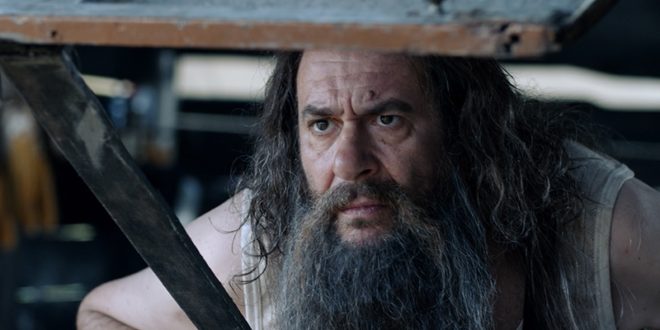We’ve all heard the expression, “Violence begets violence.” It’s true enough, but there’s a flip side to that coin. Ana Murugarren’s The Bastards’ Fig Tree (AKA La Higuera de los Bastardos), which was based on Ramiro Pinilla’s eponymous novel, looks at how political violence can drastically transform somebody from an agent of oppression to a peaceful hermit. The question is: has he changed for moral reasons, or has he merely become a coward?
The background story is pretty simple, at least on the surface. During the Spanish Civil War, fascists are targeting anyone they consider rebellious. One man, Rogelio (Karra Elejalde: Timecrimes 2007 – read our review here), ultimately regrets his involvement in murdering a a schoolteacher (Quique Gago: The Invisible Guardian 2017) who was accused of conspiring against Spain. At first, Rogelio doesn’t feel too conflicted, chanting, “Onwards, Spain!” with the others. However, when he revisits the site of the murder, he learns that the teacher’s child, Gabino (newcomer Marcos Balgañón Santamaría), has buried his father and brother himself. When Rogelio sees the murderous look in the child’s eyes, it changes him forever. But can he escape his violent past?
Interesting Themes
While The Bastards’ Fig Tree has elements of a political thriller, it’s better to watch it without a genre in mind. It’s not consistently, nail-bitingly intense enough to say it’s horror. Similarly, there are times where it’s somewhat funny. However, it isn’t quite a comedy. If the film is to be approached in any one way, it might be as an examination of guilt feelings and pacifism. Can we really become moral people just by becoming non-violent? In fact, a key part of the film is when the fascists argue, “We don’t kill, we cleanse.” It’s not a mentality unique to fascism. Any ideology can ultimately see itself as pure, righteous and towering above all others if they’re doing what they think is the right thing.
Rogelio has decided to take care of a fig tree at the murder site. One wonders if the tree is supposed to be a symbol or merely regarded as a tree. Also, to what extent is peace meaningful as opposed to a pathetic, empty gesture? While some may regard Rogelio as somewhat of a holy man, he sees himself as having to make peace with a unique burden. The Bastards’ Fig Tree looks at a man’s unique, self-imposed punishment as an ongoing purification ritual. It’s how he finds balance with himself and his place in the world. In fact, the fig tree is the only place he now belongs.
The Performances
Rogelio is already an interesting character, and Karra Elejalde shows the merits of a modest performance. Horror fans may recognize Elejalde from Timecrimes. While this film is quite different from that, there are similar themes of being trapped in a unique time and place. Marcos Balgañón Santamaría also shines as Gabino. He is effective, even though he doesn’t have much screen time. The Bastards’ Fig Tree also has memorable performances by Pepa Aniorte as Cipriana, Carlos Areces as Ermo, Mikel Losada as Pedro Alberto, Andrés Herrera as Luis and Jordi Sánchez and Benito Muro.
What are your thoughts on The Bastards’ Fig Tree? Let us know in the comments!
 PopHorror Let's Get Scared
PopHorror Let's Get Scared




